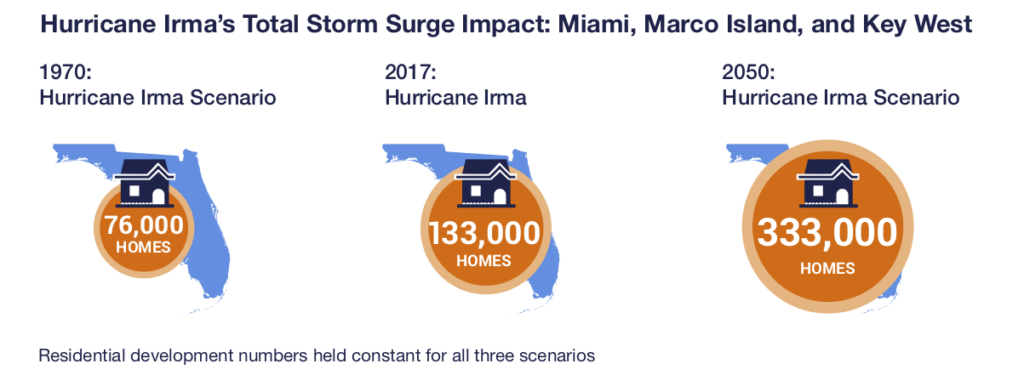With each passing hurricane season, Florida’s coastal communities brace themselves for storms that seem to be getting worse. After the devastating 2017 hurricane season and the unexpected and rapid acceleration of Hurricane Michael, homeowners are growing increasingly concerned about the effect that worsening storm surge could have on their homes.
First Street Foundation, a 501(c)(3) tech nonprofit that educates policymakers and the public about the risks, causes, and solutions to sea-level rise, set out to determine the role that sea-level rise plays in these catastrophic weather events. The results? Sea-level rise since 1970 caused an additional 57,000 homes in Florida to be affected by Hurricane Irma’s storm surge.

According to data from tide gauges in the region, relative sea level off the coast of Florida has risen approximately 7 inches since 1970. With sea levels higher, more water is available for hurricanes to push onto land, which makes storm surge worse. That additional water also removes friction that would slow down the surge.
————————————————————————–
Here are grapics showing the difference in the surge over time in Key West, Marco Island and Miami:
There were over 133,000 homes across Florida that were affected by Hurricane Irma’s storm surge last year, which caused extensive flooding and damage. Scientists from First Street Foundation modeled the impact of an Irma-like storm at the sea levels observed in 1970 and found that approximately 57,000 of the properties affected last year would not have been affected with 1970 sea levels.
“We know that sea-level rise made the damage from Hurricane Irma significantly worse,” said Steven McAlpine, Head of Data Science at First Street Foundation.
The study also found that if Hurricane Irma were to hit at the sea level the U.S. Army Corps of Engineers projects for 2050, which is another 15 inches above current levels, an additional 200,000 homes would be impacted by the surge. That means just 1.26 feet of sea-level rise would increase the number of homes impacted by Hurricane Irma’s storm surge by 150 percent.
“Small increases in sea levels are causing disproportionate increases to the reach of storm surge,” said Dr. Jeremy Porter, a professor at Columbia University who worked with First Street Foundation on the study. “This is especially true in Florida because of the low-lying topography.”
In addition to sea-level rise, the scientists found that changes in housing development patterns played a significant role in the number of homes affected by Irma’s storm surge. Since the 1970s, much of the region’s wetlands and conserved areas have been developed for urban use.
Many of the homes built in these previously undeveloped areas were impacted by Irma’s surge. Of the 133,000 homes that were impacted in 2017, the research found that nearly half—a total of 61,000—had been developed since 1970. In other words, without development since 1970, only 72,000 homes would have been impacted.
“Recent hurricanes such as Hurricane Irma, Florence, and now Michael, are demonstrating how sea-level rise has a dramatic impact on the number of homes affected by hurricane storm surge,” said Matthew Eby, Executive Director of First Street Foundation. “As sea levels and coastal development continue to rise, this will only get worse. The time to rethink America’s sea level rise and adaptation strategy is now.”
For questions about the methodology behind this research please reach out to pr@firststreet.org.
“The Invading Sea” is a collaboration of four South Florida media organizations — the South Florida Sun Sentinel, Miami Herald, Palm Beach Post and WLRN Public Media.




Comments 1